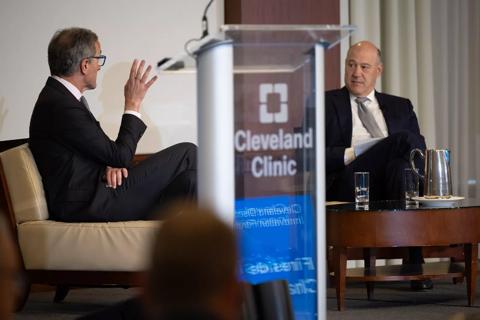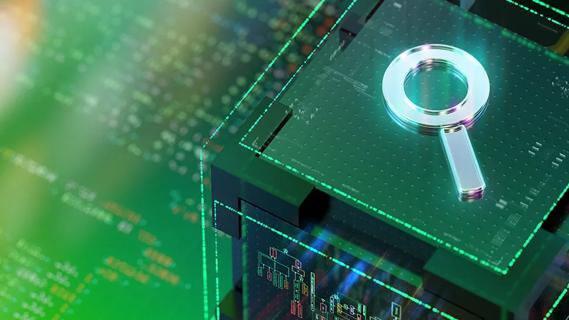Discovery Accelerator Partnership with IBM Deploys Advanced Computing Technologies to Supercharge Healthcare Research

The world’s first quantum computer devoted to healthcare research is now operational at Cleveland Clinic, part of a landmark partnership with IBM called the Discovery Accelerator that will use advanced computing technologies to hasten biomedical innovations.
Advertisement
Cleveland Clinic is a non-profit academic medical center. Advertising on our site helps support our mission. We do not endorse non-Cleveland Clinic products or services. Policy
The IBM Quantum System One is installed in the Lerner Research Institute on Cleveland Clinic’s main campus. Cleveland Clinic and IBM researchers already are devising projects that will bring quantum computing and the Discovery Accelerator’s other components to bear on highly complex challenges in areas such as drug discovery and design, genomic analysis, molecular modeling and medical imaging.
“This technology holds tremendous promise in revolutionizing healthcare and expediting progress toward new cares, cures and solutions for patients,” says Tom Mihaljevic, MD, Cleveland Clinic CEO and President and Morton L. Mandel CEO Chair. “Quantum and other advanced computing technologies will help researchers tackle historic scientific bottlenecks and potentially find new treatments for patients with diseases like cancer, Alzheimer’s and diabetes.”
Quantum computing is a radically new and rapidly evolving computing technology that has the potential to dramatically change how data is analyzed and what can be discovered from it. It uses the principles of quantum mechanics — which describe the strange ways that nature works at the subatomic level — to solve problems too complicated or massive for classical computers.
Traditional digital computers operate with binary information-storing bits, which function in only one state at a time — off or on, zero or one. Although powerful, bit-based computers struggle with problems that have multiple variables interacting in complex ways, such as trying to predict what 3D shape a chain of protein molecules will form.
Advertisement
Quantum computers use units of information called quantum bits, or qubits, which exist in multiple states simultaneously (a condition known as superposition). That capability allows qubits to hold much more information than binary bits and interact in novel ways (called entanglement and interference) to process data. Using qubits, quantum computers can create multidimensional computing environments in which the patterns that link seemingly disparate individual data points emerge.
Quantum computers can operate substantially faster and at a larger scale than classical computers, meaning they will be superior for certain data- and time-intensive uses, such as probing complex biological processes and systems. For example, simulating the energy configuration of a single caffeine molecule would require 1048 bits — an impossible processing task even for today’s most powerful supercomputers. A quantum computer could represent the molecular configuration of caffeine with 160 qubits.
The Quantum System One in place at the Discovery Accelerator uses IBM’s 127-qubit Eagle processor. Within three years, the Discovery Accelerator will be the first client facility to host IBM’s next-generation quantum computer, the 1,000+ qubit Quantum System Two. The 1,000-qubit threshold is an inflection point at which problems will be solved more efficiently on quantum computers than on the world’s best supercomputers.
Speed and efficiency are vital at a time when researchers are awash in information that must be analyzed to be understood and acted on. The volume of healthcare data — such as information from clinical trials, disease registries, electronic health records and medical devices — is growing at a compound annual growth rate of 36%. At present, it takes an average of 17 years for a scientific discovery in a biomedical research lab to become a tangible therapy or diagnostic test available to patients.
Advertisement
“It still takes forever to go from a question to an answer,” says Lara Jehi, MD, Cleveland Clinic’s Chief Research Information Officer and Discovery Accelerator Executive Program Leader. “It’s frustrating because at the same time in this digital age, we have all the data. We should be able to come up with better answers more quickly, but we can’t because the data is too much for classical computing tools to handle.”
Although other institutions may be able to access quantum computing via the cloud, they could encounter long wait times and limits on usage. “It’s hard to lead in that situation,” Dr. Jehi says. “Fortunately, thanks to our partnership with IBM, Cleveland Clinic has its own quantum computer, in the middle of one of the top healthcare systems in the world.”
In addition to quantum computing, the Discovery Accelerator’s suite of advanced computing technologies includes artificial intelligence (AI) and high-performance computing (HPC) through the hybrid cloud.
AI involves advanced computer algorithms and systems that learn from data, organize knowledge and make inferences and deductions. AI is important in areas such as natural language processing, image analysis and speech recognition, which are useful in biomedical research and clinical care. Recent advances in deep learning and foundation models have potential to leverage complex data across the biomedical spectrum, from molecular and protein data to omics and electronic health records. AI surrogate models are accelerating and lowering the cost of computing simulations in tasks such as protein structure prediction. AI generative models are valuable for scaling hypotheses generation, which is a key in drug and biomarker design and discovery.
Advertisement
HPC uses clusters of powerful processors, working in massively parallel fashion, to analyze huge datasets and solve complex problems at extremely high speeds — typically more than a million times faster than desktop or laptop computers and servers. HPC runs on clusters of high-speed computer servers networked together. In healthcare research, the power of HPC can be used for complicated processes and projects such as DNA sequencing, drug discovery and design, rapid cancer diagnosis, molecular modeling, and running artificial intelligence algorithms and simulations.
To maximize the impact of its advanced computing resources, the Discovery Accelerator will focus on eight cross-cutting areas of research that bridge multiple biomedical domains, systems, organs and diseases. This integrative approach means that discoveries in one focus area will have a synergistic effect, accelerating progress across the enterprise. The priority areas are:
Cleveland Clinic and IBM already have begun a robust portfolio of research projects likely to produce high-impact results.
Projects include:
Advertisement
The Discovery Accelerator could hold the key to making drug discovery more expeditious and cost-effective, says Shaun Stauffer, PhD, Director of Cleveland Clinic’s Center for Therapeutics Discovery.
“It’s going to change the vector,” says Dr. Stauffer, whose team is working closely with IBM to leverage AI and molecular dynamics modeling to streamline the drug discovery process.
“A big part of drug discovery is risk mitigation and risk removal,” he says. “With computational science, we have an opportunity to make smarter decisions upfront and reduce the number of compounds we have to synthesize to identify a clinical candidate. These new tools will have embedded knowledge about what to avoid. We’ll receive a clear option that should allow us to get from point A to point B with a much higher level of confidence.”
Access to quantum computing and the Discovery Accelerator’s other advanced computing resources and expertise isn’t limited to Cleveland Clinic and IBM researchers.
The facility is seeking collaborators from a variety of fields — pharmaceutical companies, academic medical centers, hospital systems, diagnostic testing laboratories, healthcare software and electronic health record system developers, research institutions, colleges and universities, government organizations, biotechnology firms, medical device companies and others.
Collaborators can import their own research project, team up with an existing Discovery Accelerator research project, or utilize the Discovery Accelerator’s computing assets via IBM’s hybrid cloud.
To further encourage collaboration and advancement in quantum computing, Cleveland Clinic is a founding partner of the Life Sciences and Healthcare Quantum Innovation Hub, an initiative led by the Washington, D.C.-based nonprofit development organization Connected DMV. Cleveland Clinic has been tapped to help define quantum computing’s role in the future of healthcare and to educate other health systems about the technology’s possibilities.
A pillar of the Discovery Accelerator’s mission is education — providing training to develop the healthcare research and technology workforce of the future and creating jobs to grow the economy.
The Cleveland Clinic-IBM partnership plans to provide innovative curricula in data science and quantum computing, offering training and certification programs designed for participants ranging from high school to the professional level, with access through grants, scholarships, fellowships and endowments. There will be research symposia and workshops intended for academia, industry, government and the public.
“We need to prepare a workforce that is able to make sense of the new technology,” says Neil Mehta, MD, a Cleveland Clinic internal medicine physician who oversees curriculum and technology as Associate Dean at Cleveland Clinic Lerner College of Medicine and who is helping lead the Discovery Accelerator education efforts along with Christine Moravec, PhD, and IBM colleagues.
“We’re already training people how to be good clinicians and good scientists,” says Dr. Moravec, Director of the Lerner Research Institute’s Research Education and Training Center. “They already speak the language of medicine and science. Now we need to train them how to speak the language of data and computation, too.”
Photo credit: Ryan Lavine for IBM
Advertisement

Advanced software streamlines charting, supports deeper patient connections

Cleveland Clinic uses data to drive its AI implementation strategy

Cleveland Clinic and IBM leaders share insights, concerns, optimism about impacts

Customized bots improve speed, efficiency by streamlining daily clinical, clerical tasks

Cleveland Clinic neuromuscular specialist shares insights on AI in his field and beyond

Neurology is especially well positioned for opportunities to enhance clinical care and medical training

How technology is changing how and whom we hire

How a Cleveland Clinic/IBM quantum computer partnership aims to hasten discoveries